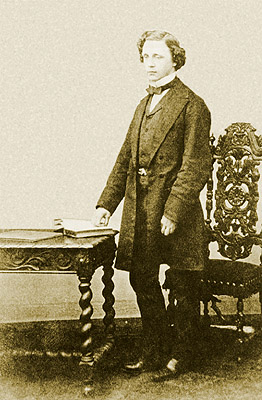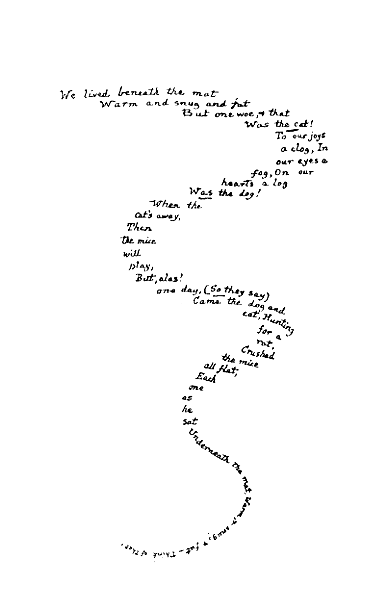Charles "Lewis Carroll" Dodgson (1832-1898)
Charles Lutwidge Dodgson was born 27 January 1832, third child and eldest son of the 11(!) children of the Reverend Charles Dodgson and Frances Lutwidge1. Like many of the Dodgson children, Charles stuttered fairly badly, something he never quite got rid of in spite of years of effort and even consultations with noted speech therapists of the day. In spite of this, Charles was comfortable playing with and even coining new words.
He attended Rugby school from 1846 to 1850, and was quite a good student, especially in mathematics. The following year, he began attending Christ Church, Oxford, his father's alma mater. Two days after he started, his mother died. His mother's younger sister, Lucy Lutwidge, moved in to help care for the family, and soon grew much beloved.
Charles received his degree with a first in mathematics2 in 1854. In spite of his stutter, he enjoyed teaching math3, and this helped him gain enough confidence to later deliver sermons as well. Charles was at this time under a studentship, which meant he would continue to study and teach at Christ Church for the rest of his life, and he was expected to remain single and also to take holy orders at some point.
Already Charles was getting various poems and short stories published in magazines. About 1855, he wrote a "Stanza of Anglo-Saxon Poetry" which would later become better known as the first four lines of Jabberwocky. Charles was very hard working and organized, which enabled him to write a great deal even though he was now Mathematical Lecturer and basically in charge of the whole math department.

In 1856, Charles asked for and received a camera and other equipment from his uncle so he could indulge in what was then a very new hobby. Around the same time, Oxford's new dean, Henry George Liddell, arrived on the scene, and Charles became very attached to the Liddell children, especially the middle daughter, Alice4.
Charles published his first book in 1860, but it probably wasn't the sort of book you're thinking of. It was actually a math treatise designed to aid struggling students5. It was on 4 July 1862 that Charles, now ordained as a deacon, told the Liddell sisters and a friend of his named Robinson Duckworth the story that was then called Alice's Adventures Under Ground. Unusually for her, Alice Liddell pestered Charles to write up the story for her, which he eventually did. Alice's Christmas present in 1864 was a handwritten copy of the story, slightly expanded, illustrated by Charles himself6.
Charles presented this handwritten copy as something of a peace offering. Though no one is quite sure (the relevant passages in Charles' diary were removed by a niece), it is probable that sometime in June of 1863, he had suggested to one or perhaps both of Alice's parents that he might someday court and marry her when she grew old enough. At that time, Alice was 11 and Charles 31, and her parents were apparently highly displeased at the suggestion. The peace offering failed, and Charles was never again on truly friendly terms with any of the Liddells.
Charles, urged to publish by those who had seen the handwritten copy, eventually published the first 2000 copies of Alice in Wonderland appear at his own expense in November of 1865 under the name "Lewis Carroll". A second edition appeared less than a year later, and sales just never quite slowed. December of 1871 saw 9000 copies of Alice Through the Looking-Glass, and Charles was suddenly famous7. His literary connections allowed him to take photographs of the rich and famous, including Tennyson, the Rossettis, and even much of the minor nobility of the time.
If this next part upsets anyone - don't shoot the messenger8. Charles also took photographs of young girls without any clothes on. All I can say in his defense is that he never made them take their clothes off, and he always asked permission from their mothers first9. He stopped photographing altogether in 1880, when it seemed as though gossip about the nude pictures might reach the ears of the girls.
Charles had a knack for befriending children which lasted all his life, and he seemed genuinely pleased to amuse them with his stories and word games, which included an early version of Scrabble. He also wrote the children's books Sylvie and Bruno and Sylvie and Bruno Concluded. His other works still included math texts which were taken quite seriously by math experts of the day, but also several satires as well as humorous poems, many of which were published in 1869 as Phantasmagoria and Other Poems.
Charles lived to see Alice in Wonderland become one of the most translated and beloved children's stories ever. He saw the first stage version in 1886, and saw edition after edition sell out. Charles died on 14 January 1898 of a severe bronchial infection, possibly aggravated by the newfangled asbestos fires he had had installed in his rooms to replace the unsafe coal fires. As for Alice, she eventually married one Reginald Hargreaves10 and sometimes toured to speak in celebration of one Lewis Carroll anniversary or another.
Cohen, Morton N. Lewis Carroll: A Biography. New York: Alfred A. Knopf, 1995.
Hudson, Derek. Lewis Carroll: An Illustrated Biography. New York: Clarkson N. Potter, Inc., 1977.

- They were also first cousins, but remember that was much more common back then.
- Getting a "First" is like getting an "A" - a really good "A". Sometimes only one person in a class gets an "A", sometimes the top few percent.
- In later life, many of Charles' pupils were interviewed about his teaching style. Not surprisingly, the ones who referred to him as 'dull' were usually the ones who absolutely hated math.
- Yep, she was that Alice. And here's a fact that might be used to impress: the Alice of the books does actually have a last name, which is Pleasance.
- It was called A Syllabus of Plane Algebraical Geometry, Systematically Arranged, with Formal Definitions, Postulates, and Axioms. Myself, I'm struggling with just the title.
- In 1928, Alice sold this handwritten copy to pay her husband's debts, incurred by trying to keep up his large, struggling estates. It sold for £15,400.
- Though he tried very hard to deny it, always returning unopened any letters he received addressed to Lewis Carroll, and even publicly denying the pseudonym as his.
- Do not send me scathing emails telling me that I'm wrong, that it was horrible, that my opinion of him is skewed, that I need to change my mind about this, that new evidence has surfaced, that the old evidence is inconclusive, or any permutation of the above.
- All I can say about that is that mothers must have been different in the 1800's. Though certainly none of the girls seemed to have any ill effects from the experience in later life. One of the girls (who may or may not have posed nude), Florence Terry, became a successful actress and later the grandmother of Sir John Gielgud.
- Her first love was forbidden by his mother to marry her. He was Prince Leopold, Queen Victoria's youngest son, and he was made to marry a German princess instead.
Photos and Illustrations
- Portrait of Lewis Carroll - c. 1865 (158k)
- Cover of Alice's Adventures Undergound - Illus. by Lewis Carroll (48k)
- 1st page of Alice's Adventures Underground - Illus. by Lewis Carroll (29k)
- Page of Alice's Adventures Underground - Handwritten by Lewis Carroll (10k)